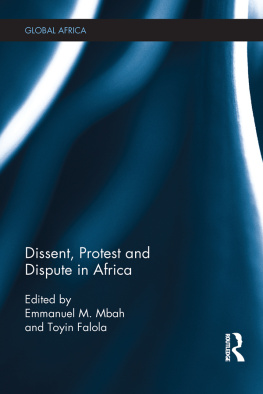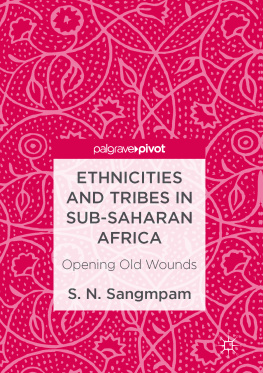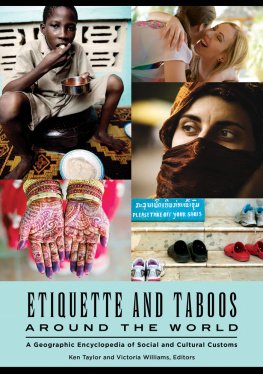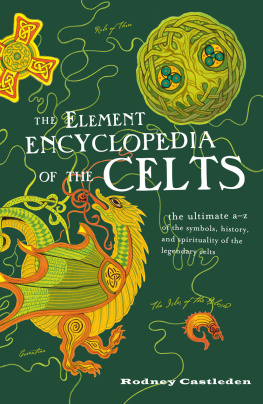

Copyright 2016 by ABC-CLIO, LLC
All rights reserved. No part of this publication may be reproduced, stored in a retrieval system, or transmitted, in any form or by any means, electronic, mechanical, photocopying, recording, or otherwise, except for the inclusion of brief quotations in a review, without prior permission in writing from the publisher.
Library of Congress Cataloging-in-Publication Data
Africa : an encyclopedia of culture and society / Toyin Falola and Daniel Jean-Jacques, editors.
volumes cm
Includes bibliographical references and index.
Contents: v. 1. A-Dv. 2. E-Mv. 3. N-Z.
ISBN 978-1-59884-665-2 (alk. paper)ISBN 978-1-59884-666-9 (ebook)1. AfricaCivilizationEncyclopedias.2. AfricaEncyclopedias.I. Falola, Toyin, editor.II. Jean-Jacques, Daniel, editor.
DT14.A3415 2016
960.03dc232015013369
ISBN: 978-1-59884-665-2
EISBN: 978-1-59884-666-9
201918171612345
This book is also available on the World Wide Web as an eBook.
Visit www.abc-clio.com for details.
ABC-CLIO
An Imprint of ABC-CLIO, LLC
ABC-CLIO, LLC
130 Cremona Drive, P.O. Box 1911
Santa Barbara, California 93116-1911
This book is printed on acid-free paper 
Manufactured in the United States of America
Contents
Preface
Africa: An Encyclopedia of Culture and Society is the product of the efforts of more than 50 scholars in the field of African Studies and related disciplines. These three volumes represent an effort by all of these authors to inform, to inspire, and to entertain. By presenting the rich diversity of African life, these volumes challenge stereotypes and assumptions and invite the reader into the world of African Studies.
Africa: An Encyclopedia of Culture and Society comprises 54 entries, 1 for each country in Africa and its associated islands. The decision to divide up a work on the cultural landscape of a continent on a country-by-country basis could be considered controversial, as cultural and political boundaries seldom correspond neatly. Indeed, this is particularly the case in Africa, where colonial occupiers carved out the borders of most of todays states with little concern for ethnicity or previous political arrangements. However, the obvious alternative, to organize this work along ethnic lines, is fraught with its own perils. By conservative estimates, Africa is inhabited by hundreds of ethnic communities. To attempt to address each one would not only require far more than three volumes but would also necessitate an uncontroversial determination of just what constitutes an ethnic group in Africa. The latter of these two requirements has, and shall likely continue, to elude scholars. Furthermore, even if these prerequisites could be met, the sheer number of groups to be considered would virtually guarantee that this work would be unable to offer each people the attention it merits.
The current political order in Africa has had, and continues to have, a profound effect on the outlooks and practices of all of Africas peoples. Organizing these volumes by country serves to elucidate, rather than obscure, the cultural life of the continent by treating the experience of ethnic groups in the context of the nations they inhabit. Equally important in the decision to adopt this organizing principle is consideration for the intended audience. While these volumes are meant to serve as a helpful reference for scholars, perhaps their most essential purpose is to offer the uninitiated a window into the cultural world of Africa. Without a background in this world, student and nonspecialist readers may not know where to begin their inquiries. Organization by country offers readers from outside of African Studies an accessible interface through which to find the answers they seek and, perhaps, to discover new questions.
Africa: An Encyclopedia of Culture and Society boasts considerably more comprehensive entries than most encyclopedic works, providing discussions ranging over a wide array of topics. Each entry in this work begins with a listing of Quick Facts about the countryCapital, Major Cities, Population, Languages, Government Type, Ethnic Groups, and Religionsand concludes with a bibliography of important print and electronic information resources. The entries themselves are divided into 15 topical sections:
Introduction (covering Geography; People and Ethnicity; and Languages)
Religion
Social Customs
Lifestyle and Leisure
Employment
Gender Roles, Marriage, and Family
Cuisine
Dress
Sports and Games
Festivals and Holidays
Music and Dance
Visual Art
Architecture and Housing
Literature and Oral Traditions
Media
By incorporating such diverse themes as these into each entry, Africa: An Encyclopedia of Culture and Society provides a reference that can address the needs of the dedicated scholar, the intrepid traveler, or simply the inquiring mind.
Contributing authors for these volumes come from diverse fields of African Studiesfrom gender studies to education and from anthropology to the history of science. Africa: An Encyclopedia of Culture and Society draws on the scholarship of experts from many institutions, scattered across three continents. Many of these experts have lived in Africa or are Africans, themselves. Thus, the voice of Africas people is alive and well in these volumes.
Acknowledgments
The editors would like to thank everyone whose efforts have been expended to make this work a reality. Many thanks to the hardworking people at ABC-CLIO, whose guidance, expertise, and patience were essential to the production of these volumes. Also, the editors would like to express their sincerest gratitude to all of our contributors who gave of their time and distinguished scholarship to generate the entries for this work. Finally, and most of all, we would like to thank the reader. It is your curiosity, your determination to go beyond a superficial understanding of Africa, that has made this project possible. These volumes are intended to challenge stereotypes and misconceptions surrounding the continent of Africa by offering a window into the diversity and richness of its cultures. This would never have been possible without the demand generated by readers like you.
Introduction
At 11.67 million square miles, Africa is the second largest continent on earth, encompassing just over one-fifth of the planets landmass. Residents of Africa represent fully one-seventh of the total world population, and population growth estimates routinely project expansion beyond 2 billion by the end of the century. Despite these facts, popular, and even academic, treatments of Africa often leave much to be desired. In popular media, Africa is rarely favored with mention, except in cases of war, famine, or disease. Africans are regularly caricatured as simple, backward, and inherently prone to lawlessness and violence. Such an image reduces Africans to hopeless victims of environmental, cultural, and even biological determinism. Such an image of Africa risks echoing the worst prejudices that have been hurled at the continentclaims of inferiority and helplessness that have been used to justify economic exploitation, colonial conquest, and slavery (United Nations Population Fund).
Within the academy, these views have seeped into many works over the years, and the funding and personnel needed to combat the slandering of one-seventh of the human race is, more often than not, lacking. For decades, however, many daring scholars have fought to bring the true Africa to lighta region that has strongly influenced the course of human history, a land of staggering diversity, a continent that has known suffering but has also known dazzling achievement.
Next page






![Michael Lovano - The World of Ancient Greece: A Daily Life Encyclopedia [2 Volumes]](/uploads/posts/book/268736/thumbs/michael-lovano-the-world-of-ancient-greece-a.jpg)





